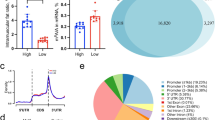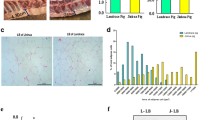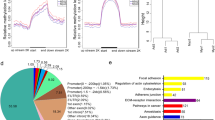Abstract
Although 5-methylcytosine (m5C) has been identified as a novel and abundant mRNA modification and associated with energy metabolism, its regulation function in adipose tissue and skeletal muscle is still limited. This study aimed at investigating the effect of mRNA m5C on adipogenesis and myogenesis using Jinhua pigs (J), Yorkshire pigs (Y) and their hybrids Yorkshire–Jinhua pigs (YJ). We found that Y grow faster than J and YJ, while fatness-related characteristics observed in Y were lower than those of J and YJ. Besides, total mRNA m5C levels and expression rates of NSUN2 were higher both in backfat layer (BL) and longissimus dorsi muscle (LDM) of Y compared to J and YJ, suggesting that higher mRNA m5C levels positively correlate with lower fat and higher muscle mass. RNA bisulfite sequencing profiling of m5C revealed tissue-specific and dynamic features in pigs. Functionally, hyper-methylated m5C-containing genes were enriched in pathways linked to impaired adipogenesis and enhanced myogenesis. In in vitro, m5C inhibited lipid accumulation and promoted myogenic differentiation. Furthermore, YBX2 and SMO were identified as m5C targets. Mechanistically, YBX2 and SMO mRNAs with m5C modification were recognized and exported into the cytoplasm from the nucleus by ALYREF, thus leading to increased YBX2 and SMO protein expression and thereby inhibiting adipogenesis and promoting myogenesis, respectively. Our work uncovered the critical role of mRNA m5C in regulating adipogenesis and myogenesis via ALYREF-m5C-YBX2 and ALYREF-m5C-SMO manners, providing a potential therapeutic target in the prevention and treatment of obesity, skeletal muscle dysfunction and metabolic disorder diseases.







Similar content being viewed by others
Availability of data and material
All data generated or analyzed during this study are included in this article. The datasets used during the current study have been deposited in the Genome Sequence Archive under the accession number CRA005591 linked to the project PRJCA007533.
Code availability
The authors declare that the codes for data analyses from this study are available from the corresponding authors on reasonable request.
References
Goodpaster BH, Sparks LM (2017) Metabolic flexibility in health and disease. Cell Metab 5(25):1027–1036. https://doi.org/10.1016/j.cmet.2017.04.015
Ukropec J, Ukropcova B, Kurdiova T, Gasperikova D, Klimes I (2008) Adipose tissue and skeletal muscle plasticity modulates metabolic health. Arch Physiol Biochem 5(114):357–368. https://doi.org/10.1080/13813450802535812
Tidball JG (2017) Regulation of muscle growth and regeneration by the immune system. Nat Rev Immunol 3(17):165–178. https://doi.org/10.1038/nri.2016.150
Yang S, Yang G, Wu H, Kang L, Xiang J, Zheng P et al (2021) MicroRNA-193b impairs muscle growth in mouse models of type 2 diabetes by targeting the PDK1/Akt signalling pathway. Diabetologia. https://doi.org/10.1007/s00125-021-05616-y
Petersen MC, Shulman GI (2018) Mechanisms of insulin action and insulin resistance. Physiol Rev 4(98):2133–2223. https://doi.org/10.1152/physrev.00063.2017
Zhao BS, Roundtree IA, He C (2017) Post-transcriptional gene regulation by mRNA modifications. Nat Rev Mol Cell Biol 1(18):31–42. https://doi.org/10.1038/nrm.2016.132
Wu R, Wang X (2020) Epigenetic regulation of adipose tissue expansion and adipogenesis by N(6) -methyladenosine. Obesity Rev. https://doi.org/10.1111/obr.13124
Yang X, Yang Y, Sun BF, Chen YS, Xu JW, Lai WY et al (2017) 5-methylcytosine promotes mRNA export - NSUN2 as the methyltransferase and ALYREF as an m(5)C reader. Cell Res 5(27):606–625. https://doi.org/10.1038/cr.2017.55
Liu RJ, Long T, Li J, Li H, Wang ED (2017) Structural basis for substrate binding and catalytic mechanism of a human RNA:m5C methyltransferase NSun6. Nucleic Acids Res 11(45):6684–6697. https://doi.org/10.1093/nar/gkx473
Selmi T, Hussain S, Dietmann S, Heiss M, Borland K, Flad S et al (2021) Sequence- and structure-specific cytosine-5 mRNA methylation by NSUN6. Nucleic Acids Res 2(49):1006–1022. https://doi.org/10.1093/nar/gkaa1193
Tang Y, Gao CC, Gao Y, Yang Y, Shi B, Yu JL et al (2020) OsNSUN2-mediated 5-methylcytosine mRNA modification enhances rice adaptation to high temperature. Dev Cell 3(53):272–286. https://doi.org/10.1016/j.devcel.2020.03.009 (e7)
Zou F, Tu R, Duan B, Yang Z, Ping Z, Song X et al (2020) Drosophila YBX1 homolog YPS promotes ovarian germ line stem cell development by preferentially recognizing 5-methylcytosine RNAs. Proc Natl Acad Sci USA 7(117):3603–3609. https://doi.org/10.1073/pnas.1910862117
Chen X, Li A, Sun BF, Yang Y, Han YN, Yuan X et al (2019) 5-methylcytosine promotes pathogenesis of bladder cancer through stabilizing mRNAs. Nat Cell Biol 8(21):978–990. https://doi.org/10.1038/s41556-019-0361-y
Yang Y, Wang L, Han X, Yang WL, Zhang M, Ma HL et al (2019) RNA 5-methylcytosine facilitates the maternal-to-zygotic transition by preventing maternal mRNA decay. Mol Cell 6(75):1188–1202. https://doi.org/10.1016/j.molcel.2019.06.033 (e11)
Van Haute L, Lee SY, McCann BJ, Powell CA, Bansal D, Vasiliauskaite L et al (2019) NSUN2 introduces 5-methylcytosines in mammalian mitochondrial tRNAs. Nucleic Acids Res 16(47):8720–8733. https://doi.org/10.1093/nar/gkz559
Moretti A, Fonteyne L, Giesert F, Hoppmann P, Meier AB, Bozoglu T et al (2020) Somatic gene editing ameliorates skeletal and cardiac muscle failure in pig and human models of Duchenne muscular dystrophy. Nat Med 2(26):207–214. https://doi.org/10.1038/s41591-019-0738-2
Koopmans SJ, Schuurman T (2015) Considerations on pig models for appetite, metabolic syndrome and obese type 2 diabetes: from food intake to metabolic disease. Eur J Pharmacol 759:231–239. https://doi.org/10.1016/j.ejphar.2015.03.044
Miao Z, Wang S, Wang Y, Wei P, Khan MA, Zhang J et al (2019) Comparison of microRNAs in the intramuscular adipose tissue from Jinhua and Landrace pigs. J Cell Biochem 1(120):192–200. https://doi.org/10.1002/jcb.27298
Wang X, Sun B, Jiang Q, Wu R, Cai M, Yao Y et al (2018) mRNA m(6)A plays opposite role in regulating UCP2 and PNPLA2 protein expression in adipocytes. Int J Obes (Lond) 11(42):1912–1924. https://doi.org/10.1038/s41366-018-0027-z
Jiang Q, Sun B, Liu Q, Cai M, Wu R, Wang F et al (2019) MTCH2 promotes adipogenesis in intramuscular preadipocytes via an m(6)A-YTHDF1-dependent mechanism. FASEB J 2(33):2971–2981. https://doi.org/10.1096/fj.201801393RRR
Wang J, Xiao J, Liu X, Gao Y, Luo Z, Gu X et al (2021) Tandem mass tag-labeled quantitative proteomic analysis of tenderloins between Tibetan and Yorkshire pigs. Meat Sci 172:108343. https://doi.org/10.1016/j.meatsci.2020.108343
Zhang W, Chen Q, Xu L, Cai J, Zhang J (2021) The potential role of PSMA6 in modulating fat deposition in pigs by promoting preadipocyte proliferation and differentiation. Gene 769:145228. https://doi.org/10.1016/j.gene.2020.145228
Li J, Zhao W, Li Q, Huang Z, Shi G, Li C (2020) Long Non-coding RNA H19 promotes porcine satellite cell differentiation by interacting with TDP43. Genes (Basel). https://doi.org/10.3390/genes11030259
Ding S, Wang F, Liu Y, Li S, Zhou G, Hu P (2017) Characterization and isolation of highly purified porcine satellite cells. Cell Death Discov 3:17003. https://doi.org/10.1038/cddiscovery.2017.3
Bolger AM, Lohse M, Usadel B (2014) Trimmomatic: a flexible trimmer for Illumina sequence data. Bioinformatics 15(30):2114–2120. https://doi.org/10.1093/bioinformatics/btu170
Kim D, Pertea G, Trapnell C, Pimentel H, Kelley R, Salzberg SL (2013) TopHat2: accurate alignment of transcriptomes in the presence of insertions, deletions and gene fusions. Genome Biol 4(14):R36. https://doi.org/10.1186/gb-2013-14-4-r36
Chen YS, Yang WL, Zhao YL, Yang YG (2021) Dynamic transcriptomic m(5) C and its regulatory role in RNA processing. Wiley Interdiscip Rev RNA 4(12):e1639. https://doi.org/10.1002/wrna.1639
Xu D, Xu S, Kyaw AMM, Lim YC, Chia SY, Chee Siang DT et al (2017) RNA binding protein Ybx2 regulates RNA stability during cold-induced brown fat activation. Diabetes 12(66):2987–3000. https://doi.org/10.2337/db17-0655
Madhala-Levy D, Williams VC, Hughes SM, Reshef R, Halevy O (2012) Cooperation between Shh and IGF-I in promoting myogenic proliferation and differentiation via the MAPK/ERK and PI3K/Akt pathways requires Smo activity. J Cell Physiol 4(227):1455–1464. https://doi.org/10.1002/jcp.22861
David R, Burgess A, Parker B, Li J, Pulsford K, Sibbritt T et al (2017) Transcriptome-wide mapping of RNA 5-methylcytosine in Arabidopsis mRNAs and noncoding RNAs. Plant Cell 3(29):445–460. https://doi.org/10.1105/tpc.16.00751
Amort T, Rieder D, Wille A, Khokhlova-Cubberley D, Riml C, Trixl L et al (2017) Distinct 5-methylcytosine profiles in poly(A) RNA from mouse embryonic stem cells and brain. Genome Biol 1(18):1. https://doi.org/10.1186/s13059-016-1139-1
Xing J, Yi J, Cai X, Tang H, Liu Z, Zhang X et al (2015) NSun2 promotes cell growth via elevating cyclin-dependent kinase 1 translation. Mol Cell Biol 23(35):4043–4052. https://doi.org/10.1128/MCB.00742-15
Li Q, Li X, Tang H, Jiang B, Dou Y, Gorospe M et al (2017) NSUN2-mediated m5C methylation and METTL3/METTL14-mediated m6A methylation cooperatively enhance p21 translation. J Cell Biochem 9(118):2587–2598. https://doi.org/10.1002/jcb.25957
Flores JV, Cordero-Espinoza L, Oeztuerk-Winder F, Andersson-Rolf A, Selmi T, Blanco S et al (2017) Cytosine-5 RNA methylation regulates neural stem cell differentiation and motility. Stem Cell Reports 1(8):112–124. https://doi.org/10.1016/j.stemcr.2016.11.014
He X, Yang Z, Chu XY, Li YX, Zhu B, Huang YX et al (2022) ROR2 downregulation activates the MSX2/NSUN2/p21 regulatory axis and promotes dental pulp stem cell senescence. Stem Cells 3(40):290–302. https://doi.org/10.1093/stmcls/sxab024
Niu X, Yang B, Liu F, Fang Q (2020) LncRNA HOXA11-AS promotes OSCC progression by sponging miR-98-5p to upregulate YBX2 expression. Biomed Pharmacother 121:109623. https://doi.org/10.1016/j.biopha.2019.109623
Chen F, Liu M, Yu Y, Sun Y, Li J, Hu W et al (2019) LINC00958 regulated miR-627-5p/YBX2 axis to facilitate cell proliferation and migration in oral squamous cell carcinoma. Cancer Biol Ther 9(20):1270–1280. https://doi.org/10.1080/15384047.2019.1617571
Wu X, Xiao S, Zhang M, Yang L, Zhong J, Li B et al (2021) A novel protein encoded by circular SMO RNA is essential for Hedgehog signaling activation and glioblastoma tumorigenicity. Genome Biol 1(22):33. https://doi.org/10.1186/s13059-020-02250-6
Xiao X, Tang JJ, Peng C, Wang Y, Fu L, Qiu ZP et al (2017) Cholesterol modification of smoothened is required for hedgehog signaling. Mol Cell 1(66):154–162. https://doi.org/10.1016/j.molcel.2017.02.015 (e10)
Yang C, Zheng X, Ye K, Sun Y, Lu Y, Fan Q et al (2021) Retraction notice to: miR-135a inhibits the invasion and migration of Esophageal cancer stem cells through the hedgehog signaling pathway by targeting Smo. Mol Ther Nucleic Acids 26:1198. https://doi.org/10.1016/j.omtn.2021.09.012
Eckwahl M, Xu R, Michalkiewicz J, Zhang W, Patel P, Cai Z et al (2020) 5-Methylcytosine RNA modifications promote retrovirus replication in an ALYREF reader protein-dependent manner. J Virol. https://doi.org/10.1128/JVI.00544-20
Acknowledgements
We would like to thank the reviewers for their constructive comments.
Funding
This work is supported by the Natural Science Foundation of Zhejiang Province (LZ22C170002); the National Natural Science Foundation of China (U21A20249); the Fundamental Research Funds for the Central Universities (2019XZZX003-13); the National Key R & D Program (2018YFD0500400); the National Natural Science Foundation of China (31572413); the Natural Science Foundation of Zhejiang Province (LZ17C170001).
Author information
Authors and Affiliations
Contributions
YHL, YY, RFW, XL, BTZ, CQH, YJL, YXL, YSC, WC, QJL, QJ, YLZ, ZB, GQG and YXY performed experiments under the supervision of XXW. YHL, CCG and XH performed bioinformatics analysis of sequence data. YHL wrote the manuscript under the supervision of XXW. YX, XJZ, YZW and XXW designed the project and XXW provided the final approval of the manuscript. Teresa G. Valencak reorganized the writing and figure layout, and revised the typo errors and grammar mistakes throughout our manuscript.
Corresponding author
Ethics declarations
Conflict of interest
The authors declare no conflict of interest.
Ethical statement
Sample collection in this study was performed according to the guidelines for the care and use of experimental animals established by the Ministry of Agriculture of China. All procedures were approved by the Committee on Animal Care and Use and Committee on the Ethics of Animal Experiments of Zhejiang University (ZJU2015-458-09).
Additional information
Publisher's Note
Springer Nature remains neutral with regard to jurisdictional claims in published maps and institutional affiliations.
Supplementary Information
Below is the link to the electronic supplementary material.




Rights and permissions
Springer Nature or its licensor holds exclusive rights to this article under a publishing agreement with the author(s) or other rightsholder(s); author self-archiving of the accepted manuscript version of this article is solely governed by the terms of such publishing agreement and applicable law.
About this article
Cite this article
Liu, Y., Yang, Y., Wu, R. et al. mRNA m5C inhibits adipogenesis and promotes myogenesis by respectively facilitating YBX2 and SMO mRNA export in ALYREF-m5C manner. Cell. Mol. Life Sci. 79, 481 (2022). https://doi.org/10.1007/s00018-022-04474-0
Received:
Revised:
Accepted:
Published:
DOI: https://doi.org/10.1007/s00018-022-04474-0




